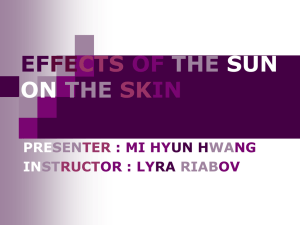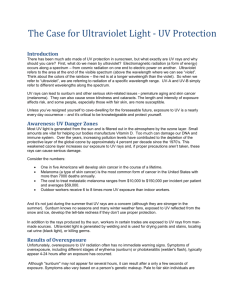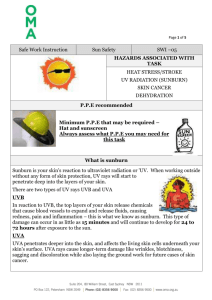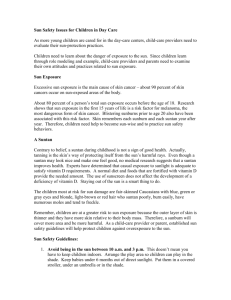File
advertisement
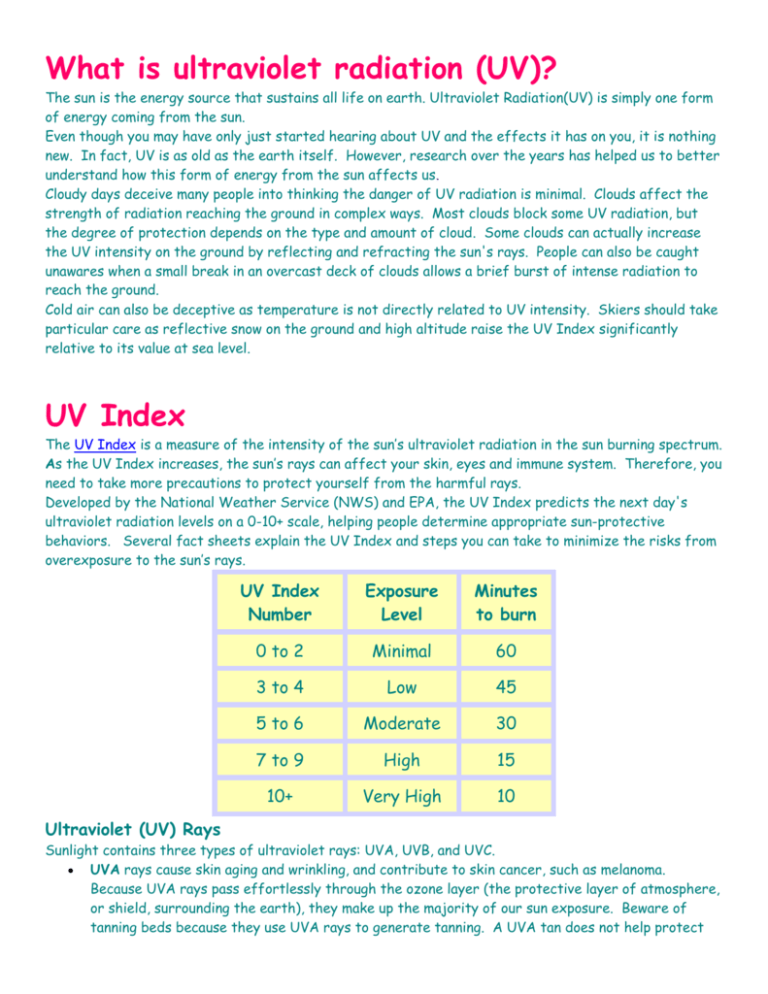
What is ultraviolet radiation (UV)? The sun is the energy source that sustains all life on earth. Ultraviolet Radiation(UV) is simply one form of energy coming from the sun. Even though you may have only just started hearing about UV and the effects it has on you, it is nothing new. In fact, UV is as old as the earth itself. However, research over the years has helped us to better understand how this form of energy from the sun affects us. Cloudy days deceive many people into thinking the danger of UV radiation is minimal. Clouds affect the strength of radiation reaching the ground in complex ways. Most clouds block some UV radiation, but the degree of protection depends on the type and amount of cloud. Some clouds can actually increase the UV intensity on the ground by reflecting and refracting the sun's rays. People can also be caught unawares when a small break in an overcast deck of clouds allows a brief burst of intense radiation to reach the ground. Cold air can also be deceptive as temperature is not directly related to UV intensity. Skiers should take particular care as reflective snow on the ground and high altitude raise the UV Index significantly relative to its value at sea level. UV Index The UV Index is a measure of the intensity of the sun’s ultraviolet radiation in the sun burning spectrum. As the UV Index increases, the sun’s rays can affect your skin, eyes and immune system. Therefore, you need to take more precautions to protect yourself from the harmful rays. Developed by the National Weather Service (NWS) and EPA, the UV Index predicts the next day's ultraviolet radiation levels on a 0-10+ scale, helping people determine appropriate sun-protective behaviors. Several fact sheets explain the UV Index and steps you can take to minimize the risks from overexposure to the sun’s rays. UV Index Number Exposure Level Minutes to burn 0 to 2 Minimal 60 3 to 4 Low 45 5 to 6 Moderate 30 7 to 9 High 15 10+ Very High 10 Ultraviolet (UV) Rays Sunlight contains three types of ultraviolet rays: UVA, UVB, and UVC. UVA rays cause skin aging and wrinkling, and contribute to skin cancer, such as melanoma. Because UVA rays pass effortlessly through the ozone layer (the protective layer of atmosphere, or shield, surrounding the earth), they make up the majority of our sun exposure. Beware of tanning beds because they use UVA rays to generate tanning. A UVA tan does not help protect the skin from further sun damage; it merely produces color and a false sense of protection from the sun. UVB rays are also dangerous, causing sunburns, cataracts (clouding of the eye lens), immune system damage, and contributing to skin cancer. Melanoma, the most dangerous form of skin cancer, is thought to be associated with severe UVB sunburns that occur before the age of 20. Most UVB rays are absorbed by the ozone layer, but enough of these rays pass through to cause serious damage. UVC rays are the most dangerous, but fortunately, these rays are blocked by the ozone layer and don’t reach the earth. Melanin Melanin is the protective chemical in the skin that absorbs UV rays and causes tanning. It is found in a variety of colors and concentrations, resulting in different skin colors. Most people have a blending of melanin colors in their skin but tend to have a dominant shade: red, found primarily in Northern Europeans yellow, found primarily in Asians brown, found primarily in African, Native and South American, and South Pacific people Yellow and red melanin found in light-skinned persons provide the least amount of sun protection. Brown melanin found in darker-skinned persons reflects the most UV and provides the most sun protection. Both dark- and light-skinned people need protection from UV rays because any tanning or burning causes skin damage. Everyone should always wear sunscreen with a minimum SPF of 15. Effects of Sunlight The effect of sunlight is more dangerous than most people think. Skin cancer is an obvious disease that is a direct affect of the sun. In the United States, many organizations are targeting the reduction of skin cancer. This has led to extensive efforts to raise awareness of the risks involved in overexposure to the sun and of the behavioral changes needed to avoid it. Melanoma is one type of cancer that can strike people of any age, race, gender, and economic status. It is the most common cancer for women ages 25 to 29. Sunburn A sunburn develops when the amount of UV exposure is greater than what can be protected against by the skin’s melanin. The lighter your skin, the less melanin it has to absorb UV and protect itself. And all skin, no matter what color, responds to continued sun exposure by thickening and hardening, resulting in leathery skin and wrinkles later in life. Unprotected sun exposure is even more dangerous if you have moles on your skin, very fair skin and hair, or a family history of skin cancer, including melanoma. You should be especially careful about sun protection if you have one or more of these high-risk characteristics. Not all sunlight is “equal” in UV concentration. The intensity of the sun’s rays depends upon the time of year, as well as the altitude and latitude of your location. UV rays are strongest during summer. Remember that the timing of this season varies by location; if you travel to a foreign country during its summer season, you’ll need to pack the strongest sun protection you can find. Skin Cancer According to the American Cancer Society (1999), skin cancer is the most common of all cancers. The incidence of skin cancer is greater than the incidence of breast, lung, prostate, colorectal, and kidney cancers combined. In the United States, about 1.3 million new cases of skin cancer are diagnosed each year. Here are statistics from the American Cancer Society 2001: More than one million new cases of basal cell and squamous cell carcinoma will be detected in 2001. 47,700 new cases of malignant melanoma will be diagnosed in 2001. In 2001, skin cancer will claim the lives of approximately 9,800 people, 7,800 of these from melanoma and 2,000 from other skin cancer. Exposure to UV radiation appears to be the most important environmental factor in the development of skin cancer. Scientists believe that the increase in skin cancer has resulted from: Increased outdoor leisure time Decrease in the amount of clothing worn outdoors Decrease in atmospheric ozone levels Skin cancer is a largely preventable disease. Exposure to UV radiation may be the most important preventable factor in determining a person’s risk for skin cancer (American Academy of Dermatology, 1998). Skin color is the most important factor determining a person’s risk for skin cancer. There are three major types of skin cancers: basal cell carcinoma, squamous cell carcinoma, and melanoma. Eye Damage Sunlight is the primary source of UV radiation that can damage tissues of the eye. Results from dozens of studies suggest that spending long hours in the sun without eye protection increases the chances of developing eye diseases, including cataracts. The 1998 Journal of the American Medical Association reported that even low amounts of sunlight can increase the risk of developing eye disorders. The American Academy of Ophthalmology has cautioned that excess exposure to UV radiation may increase the incidence of cataracts. Cataracts are a form of eye damage that causes the loss of transparency in the lens, clouding vision. Everyone is at risk for developing cataracts. Another potential effect of UV radiation is a “burning” of the eye surface, called “snow blindness” or photokeratitis from sunlight. The effects usually disappear within a couple of days, but may lead to further complications later in life. UVB damage to the eyes is also cumulative, so it is never too late for people to start protecting their eyes. Photo aging/Wrinkling A very high percentage of age-associated cosmetic skin problems can be attributed to sun (Levine, 1997). Chronic overexposure to the sun changes the texture and weakens the elastic properties of the skin. The epidermis, which is the outer layer of the skin, thickens, becomes leathery, and wrinkles as a result of sun exposure. The difference between skin tone, wrinkles, or pigmentation on the underside of a person’s arm and the top side of the same arm illustrate the effects of sun exposure on skin. In most cases, the top side of the arm has had more exposure to the sun and shows greater sun damage. Suninduced skin damage causes wrinkles and furrows, easy bruising, brown or “liver spots”, precancerous lesions (actinic keratoses), and potentially skin cancer (Skin Cancer Foundation, 1992). Because photo aging of the skin is cumulative, it is never too late for a person to start a sun protection program. Immune System Suppression Scientists believe sunburns can alter the distribution and function of disease-fighting white blood cells in humans for up to 24 hours after exposure to the sun. Repeated overexposure to UV radiation can cause more damage to the body’s immune system. Mild sunburns can directly suppress the immune functions of human skin where the sunburn occurred, even in people with dark skin. Guidelines for Protection Eye Protection Sunglasses are not just a fashion accessory. Sunglasses offer excellent protection for your eyes. Like your skin, your eyes are at risk of damage and trauma if exposed to too much UV radiation or "UV." When buying sunglasses, you can gauge their effectiveness by checking the swing tag on the sunglasses to ensure lenses block out 95% of UV. Polychromatic or colored glasses are less effective in blocking out UV. Polarizing lenses reduce glare substantially and are favored by many people for comfort, but polarization itself has little effect on the UV-absorbing properties of lenses. Similarly, mirror finishes by themselves do not significantly reduce UV absorption. Correct use of sunglasses should begin during childhood, but no one is too old to begin wearing them. If you wear corrective lenses, you should add UV-protective coating or obtain prescription sunglasses if you spend significant periods outside. You can buy protective shades to attach to your glasses or sunglasses that you can wear over your corrective lenses. Tanning Protection Suntan lotion is used to protect your skin from the sun’s damaging ultraviolet radiation or ‘UV’. When choosing a sunscreen that will protect you, there are a few things you should know: No sunscreen offers 100% protection from the sun’s damaging UV. Even with sunscreen, UV will still get through to the fragile upper and lower layers of your skin. Sunscreen should always be used in conjunction with other forms of protection like hats, sunglasses, clothing and shade. Sun protection factor (SPF) 30+ sunscreen offers you maximum protection from the sun, blocking out 96% of UV. SPF 15+ will block out 93%. Using SPF 30+ instead of SPF 15+ does not mean you can safely double the amount of time you spend in the sun. Never use sunscreen to extend the amount of time you would normally spend in the sun. For sunscreen to be effective at protecting you from sunburn, slop it on 20 minutes before going outside. This gives the protective elements in sunscreen time to bond to your skin. Don’t rub it in—a light film should stay visible. Remember to reapply every two hours or more regularly if swimming or sweating a lot. If you experience a reaction to sunscreen, experiment with other brands first, before giving sunscreen away. It is often the fragrances or moisturizers in sunscreen that cause skin irritation. Try sensitive skin formulas or brands especially made for children. Clothing Protection Appropriately designed clothing is great for protecting you from the sun. Choose clothes that cover the arms, legs and neck to ensure you are properly protected. Go for long sleeves, collars and if possible long pants or skirts. You won’t get hot or uncomfortable if you choose lightweight fabrics like cotton, hemp or linen. The tests on clothing show that most polyester/cotton and cotton clothing items protect against 95% of ultraviolet radiation or 'UV'. Some factors can reduce the UV protection of your clothing. If your clothing gets wet, fades or is a few years old, its ability to shade against UV will be reduced. If you are looking for very high sun protective clothing - for outdoor work, bushwalking or for sport choose dark colors, as they are better at absorbing UV than light colors.
